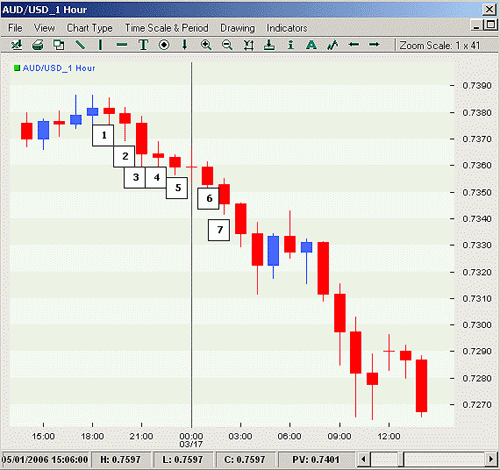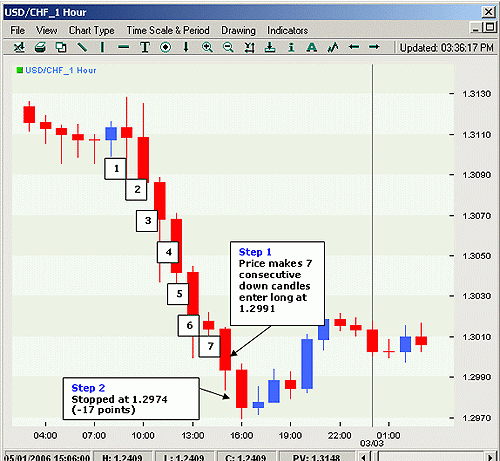Extension Fade Of Seven days Forex strategy
Post on: 16 Март, 2015 No Comment

Trying to choose tops and bottoms with not type of support from an indicator is regarded as one of the lighten ways of doing trade. However, the extension fade of seven days is regarded as strategy that does this. Here, we will move over how the particular strategy works and depict you certain examples of failed as well as successful set up.
What it is?
The fade of seven day extension depends on a premise that after completing seven days of the consecutive power, a move of the currency pair is because of the retracement. This particular numbers is drawn by observing the activity of regular market. Most of the time when the week starts a recent trend is emerged. If a tendency is really strong, it lasts for many days with no type of retracement.
However, following seven days of successive power that encompasses about a week and half of the uninterrupted movement costs should be paused. Generally, individuals believe in collections of seven. It is properly documented that several psychologists think that most of the people have proper rates of retention on the numbers which are in the collection of seven and also sometimes less than that. This is one part of the cause why the phone numbers in U.S only consists of seven digits, apart from the course’s area code.
Therefore, although six days of the exhaustion does the work, the reversal pattern of seven days is considered to be more perfect. Shifts lasting for nearly eight days start in an occasional way but are really rare. This is the point where the discretion can be utilized in an effective manner. If the sixth or fifth day of the exhaustion coincides with the important level of technicians, the shift might stall at this specific point. However, searching for the highest possibility deals, the method of seven day is preferred. Even if a setup is uncommon, when it starts occurring, it plays a vital role. AAs the trends of sentiments are really intractable in a market, all the day, setup is not reliable as the hourly charts, Trends lasting for eight hours prior to the reverse are a bit common, while we notice the trends lasting for eight days without retracement on the daily chart.
Ultimately, a very vital condition of the particular setup is that each candle in the uptrend should be positive and each candle in the downtrend should be negative. If a sequence of the seven candles gets intermittent by the neutral candle, candle where close is equal to open, count should begin from a scratch.
Strategy rules
Rules for this particular strategy are simple as it depends on the candlesticks and the cost. Accuracy of a strategy rises when the candle in the seventh number coincides with the important technical level.
Rules and Regulations for the Long Trade
1. Search for the seven bars of weaknesses, where every close of the bar is under the previous close.
2. Purchase at an open of the following bar.
3. Place the stop at a low of seventh bar subtracted from ten pips.
4. The initial target is the risked amount. Shift a stop on the other half of the breakeven
5. The other target is nearly three times of the risked amount.
Rules for Short Trade
1. Search for the seven bars of power where every close of every bar is more than the earlier close.
2. Do selling at an open of the following bar
3. Keep the stop at high of seventh bar added with ten pips
4. The initial target is the risked amount. Shift the stop on remaining part to the breakeven
5. Another target is about three times of the risked amount.
Long Trade
The initial instance is a regular chart of nzd usd. The pair of currency starts the downtrend on 15 Dec, in the year 2005 lasting for nearly seven days. We make an entry at an open of a candle on eighth day placing the entry cost at 0.6723. Reversal takes place on second day and the exit order is started. We then shift to the breakeven and place the second take-gain order at nearly three times that risked amount or about 0.6822. This particular order is triggered for five days afterwards, permitting one to capture sixty six pips on the deal for a risk reward ratio of 2:1.

The given figure depicts the strategy on a temporary chart of time frame for USD/EYR. We notice EUR/USD start to sell on 2nd April in the year 2006. After the seventh hour gets closed we start placing a particular order to purchase an open or about 1.2407. Both the targets are generally hit between trading sessions of U.S and Europe, earning a total of fifty pips on a whole deal.
Examples Short Trades
Looking for examples on a short side, mainly on a short time frame, are mostly easier than looking for instances on a long side. Most of the sell-offs lasts closer to five days instead of the seven. This can be because most of the dealers have mainly come from stock market. They are ingrained to purchase than to sell, as the age old of the market but defunct and upticking rule.
The initial instance on short deal is a regular chart of CHF/USD. We notice that on the month of January on 28 in the year 2005, the CHF/USD starts trending in an upward direction. The shifts last for nearly one week at which the time we start a small position on an opening of the number eighth candle. The entry cost is 1.2242 and the stop is ten pips over high of the earlier candle.
We notice that USD/GBP starts to rally in a short manner after the opening of the trading session of U.S. takes place. The rally continues for seven candles, right till the market of U.S starts closing. The stop is recorded at ten pips over high of the earlier candle or nearly 1.7557. The danger is tiny, only ten pips, which signifies that the initial target is close to nearly 1.7537.
In another instance on right part of the similar chart, we notice USD/GBP starts rallying in a short manner after a stronger one is released than it is expected. The rally continues till 10 in the morning. At 10 the market expected the Michigan University. The powerful ISM number turned a market strong dollars and the USD/GBP started collapsing. However, in these examples the nimble take gain levels helped one catch nearer bottom of the shifts.
When Strategy Failed
Let us take a glance at a hourly chart for instance, several readers might be very impatient for waiting for a rare case, yet potent extension fading on regular charts and instead choose implementing them on the hourly charts. The selling off continues to the seventh candles and on an opening of eighth candle also, we keep an order to move long way of the currency at about 1.2991 with the stop ten pips under a low of the earlier candle. Unluckily, the weakness starts extending for another bar prior to the moment at actually starts reversing and we attain stopped out for the loss of seventeen pips.
Also, there is one extra point that we will bring in notice which is shown in an hourly USD/AUD chart displayed above. We count nearly seven candles then look for making an entry at an opening of the candle number eight. However, we notice that opening is already at lower part of the earlier candle telling that a shift is set for continuing for another bar, thus, we select not to do this trade.
Bottom Line
As shown in several examples shown here is when one catches the turn, it generally extends for over three times catching the turn. Thus, it is certainly a scheme that involves large number of discretion in which the dealers might want trailing the stops by utilizing two-bar high for capturing large number of profits. On the other hand, if you find a fading setup on the regular charts, you might want to trail the stop by utilizing the hourly charts. The entire premises of this scheme depend on a saying that what moves on and what should come down.














